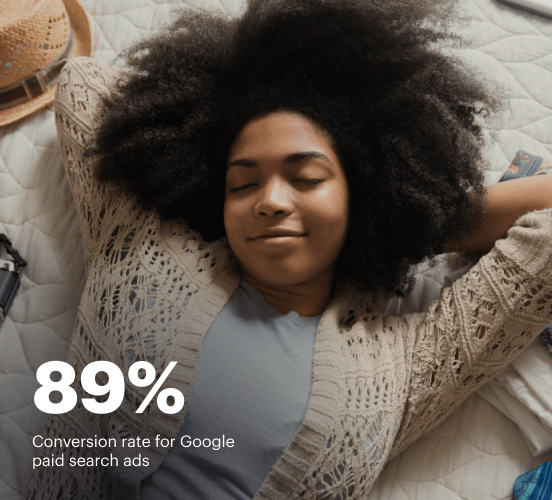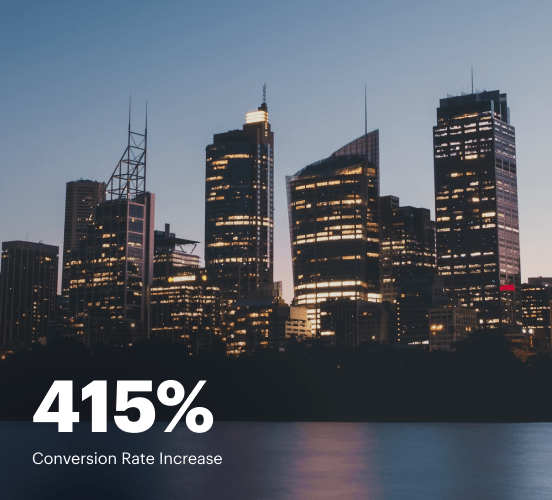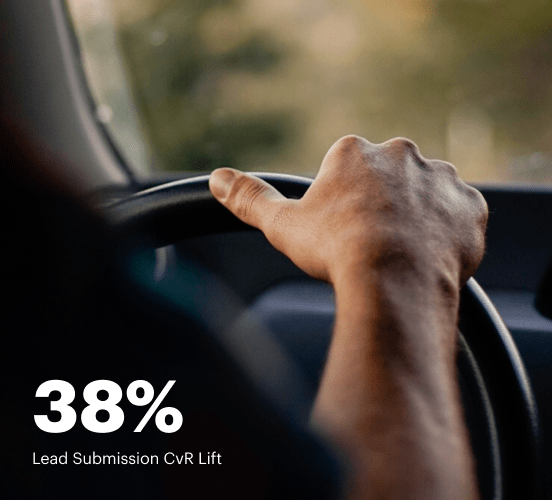How Canva vs. Tilda vs. Instapage stack up against each other
Compare Instapage with Canva and Tilda to create high-converting landing pages. With personalization, optimization, and collaboration tools, Instapage helps you deliver experiences that drive results.
Get startedSee how Instapage stacks up against the competition
| Feature | Instapage | Other builders |
| Drag-and-Drop Tools | ||
| Conversion-optimized templates | ||
| Manual and AI-powered A/B Tests | ||
| AI content suggestions | ||
| Popups and sticky bars | ||
| Canvas and grid blocks | ||
| Reusable and global elements | ||
| Form and popup builders | ||
| Built-in Heatmaps | ||
| Central analytics dashboard | ||
| Ad-to-page personalization and collections | ||
| Contacts, lists, and email | ||
| Dedicated, full-service CRO experts | ||
| Enterprise-ready platform |
Leading the way in building high-performing landing pages





Why Instapage is the smarter choice for your campaigns
Get everything you need to build, scale, and optimize high-converting landing pages—without coding.

Easier page building without coding
Instapage offers a flexible and seamless page creation experience with a library of 500+ conversion-focused layouts, Instablocks®, a drag-and-drop builder, and AI content generation. With technologies like Thor Render Engine®, you can create on-brand, mobile-responsive landing pages that load quickly and start converting during initial visitor clicks.

More insights — better results
Instapage lets you see in detail how each landing page experience and variation is performing so you can make targeted changes that boost page conversions. Use heatmaps for a better understanding of on-page activities, run A/B tests and AI-assisted experiments, and then track and evaluate results within robust analytics dashboards.

More personalized experiences
Instapage lets you quickly create high-performing landing pages tailored to each of your ad campaigns. Deliver personalized experiences for distinct audiences using dynamic text replacement. Effortlessly align specific advertisements to unique pages with AdMaps. Monitor audience-level metrics using our advanced data tools.

Built-in collaboration
Instapage collaboration capabilities bring your entire team together to speed up the process of landing page review, approval, and launch. No more frustrating and unnecessary revisions or edits scattered across emails. Provide instant feedback, conduct real-time page edits, and securely share your pages with outside stakeholders.

Free up time for your business
Invest time into business growth, not busy work. Launch landing pages faster with reusable forms and templates. Build once, reuse forever.
Explore all integrations






Easier page building without coding
Instapage offers a flexible and seamless page creation experience with a library of 500+ conversion-focused layouts, Instablocks®, a drag-and-drop builder, and AI content generation. With technologies like Thor Render Engine®, you can create on-brand, mobile-responsive landing pages that load quickly and start converting during initial visitor clicks.
More insights — better results
Instapage lets you see in detail how each landing page experience and variation is performing so you can make targeted changes that boost page conversions. Use heatmaps for a better understanding of on-page activities, run A/B tests and AI-assisted experiments, and then track and evaluate results within robust analytics dashboards.
More personalized experiences
Instapage lets you quickly create high-performing landing pages tailored to each of your ad campaigns. Deliver personalized experiences for distinct audiences using dynamic text replacement. Effortlessly align specific advertisements to unique pages with AdMaps. Monitor audience-level metrics using our advanced data tools.
Built-in collaboration
Instapage collaboration capabilities bring your entire team together to speed up the process of landing page review, approval, and launch. No more frustrating and unnecessary revisions or edits scattered across emails. Provide instant feedback, conduct real-time page edits, and securely share your pages with outside stakeholders.
Free up time for your business
Invest time into business growth, not busy work. Launch landing pages faster with reusable forms and templates. Build once, reuse forever.
Explore all integrationsGet started with Instapage in a few steps
-
Create your Instapage account
Start with Instapage by signing up via Google or your email. You'll get access to a free 14-day trial to discover Instapage capabilities. Feel free to cancel anytime during the 14-day trial if you decide that our product is not suitable for your business. -
Build and personalize your page
Create your first landing page from scratch or choose a template from 500+ customizable layouts. Use the drag-and-drop builder to add page elements, fonts, and backgrounds, refine content with AI, or add custom HTML, Javascript, and CSS. -
Review and make edits
Collaborate on page designs and streamline review processes. Invite your team members and stakeholders to review, edit, and provide feedback on your landing page. Collaborate knowing your page is confidential and only accessible to authorized users. -
Publish and track page performance
Publish your page to a domain or custom URL. Connect your pages to the ads you've created and track page performance within the analytics dashboard, run A/B tests and AI experiments, analyze results, and continuously optimize your landing page to maintain high conversions.
Instapage, Canva, and Tilda: The Battle for Landing Page Supremacy
Choosing the right landing page builder can often feel like assembling your ultimate dream team, akin to rounding up superheroes for an epic showdown. Each tool brings unique talents to the table, hoping to capture the hearts and minds of marketers around the globe. Whether you’re looking to captivate your audience or drive conversions, the choice can significantly impact your marketing strategy. In this article, we will put three formidable contenders to the test—Instapage, Canva, and Tilda—examining how they stack up against each other in various critical facets. And while we'll give fair credit to the competition, it's worth noting how Instapage empowers marketers to reduce costs, grow conversions, and deliver relevant landing page experiences that increase brand trust, customer loyalty, and conversion rates. Get ready for an informative yet enjoyable ride as we dissect these landing page builders to determine which one truly reigns supreme.
Meet the Competitors: A Quick Overview
In one corner, we have Instapage, a dedicated landing page builder designed for optimization and performance. With a suite of powerful tools, it appeals directly to marketers aiming to boost their conversion rates. Across the ring is Canva, well-known for its user-friendly design capabilities that extend beyond just landing pages. Blessed with a plethora of templates, Canva is a favorite amongst creatives looking to whip up visually stunning pages quickly. Last but not least is Tilda, a visually focused web builder known for its unique blocks and flexibility, appealing particularly to design-centric users. With each of these platforms bringing something different to the table, let’s dive deeper to see how they fare in their respective realms.
Feature Showdown: What Makes Each Tool Tick?
Template Selection and User Experience Comparison
When it comes to features, the diversity of templates and user experience plays a vital role in the selection process. Canva shines in this area, boasting an extensive library of visually appealing templates that can be edited with ease. With its drag-and-drop interface, users can quickly create on-brand landing pages without requiring extensive technical knowledge. Tilda also offers an impressive range of templates, featuring unique blocks that allow for a high degree of customization and a visually intriguing presentation. What stands out, however, is Instapage’s focus on optimizing conversion rates. With its robust A/B testing feature and analytics integration, Instapage allows marketers to fine-tune their landing pages in a way that drives better results. Thus, while Canva and Tilda provide creative flexibility, they don’t quite match the targeted conversion optimization capabilities of Instapage.
The Power of Instapage for Customization and Optimization
Instapage takes the crown when it comes to customization and conversion optimization tools. With its intuitive interface, marketers can build highly tailored landing pages that align closely with their branding and objectives. The platform offers extensive customization options, enabling users to alter every aspect of their pages—from fonts and colors to button placements—to create an engaging user experience. Additionally, Instapage is equipped with behavioral targeting and dynamic text replacement, ensuring that the right message reaches the right audience at the right time. Beyond aesthetics, this platform focuses on data-driven results. Its advanced analytics feature empowers marketers to gauge the effectiveness of their landing pages accurately, providing insights that foster continuous improvement. Thus, rather than merely being a tool, Instapage positions itself as a reliable partner for marketers striving for success.
Speed and Performance: Who Delivers?
Speed is a critical component when delivering a seamless user experience. Imagine walking into your favorite coffee shop, eager for a quick caffeine boost, only to be met with an interminably long wait. Just like that frustrating experience, slow-loading pages can significantly deter users, increasing bounce rates and diminishing conversions. As we examine the speed and performance of our contenders, keep in mind how essential it is for your landing pages to load quickly and efficiently.
Instapage Benefits:
- High-speed loading times that enhance user experience.
- Optimized assets automatically for faster performance.
- Reliable uptime and excellent server response times.
- Resources dedicated to ensuring landing pages are lightweight.
Canva Benefits:
- Templates optimized for web performance.
- Fast preview loading times within the design interface.
- Export options that maintain quality while keeping file sizes low.
Tilda Benefits:
- Efficient loading due to its unique block system.
- Offers image optimization features for faster loading.
- Good server infrastructure that supports quick access.
In summary, while all three platforms offer decent speed and performance, Instapage takes the edge with its dedicated focus on ensuring quick loading times and minimal bounces. It's clear that for marketers wishing to enhance their user experience, Instapage should be a top consideration.
Navigating Usability and Learning Curves
Usability is a vital aspect of any landing page builder, especially for those who are new to the game or wish to ramp up their skills quickly. The good news is, all three platforms are fairly accessible. Canva is arguably the most user-friendly option out of the trio, with its intuitive drag-and-drop functionality allowing users to create beautiful pages without requiring prior experience. Those who are design-oriented will find Tilda’s block-based approach welcoming, empowering them to customize effortlessly while benefiting from a short learning curve. As for Instapage, while it may have a steeper learning curve initially due to its advanced features, it rewards users with the ability to create highly optimized pages crucial for conversion success. Thus, while the entry into each platform varies, each awaits users with a promising journey towards mastery.
Customer Support: The Teams Behind the Tools
Think of customer support as the trustworthy sidekick always ready to help when challenges arise. In exploring how each platform manages user support, we find distinct strengths. Canva offers extensive resources in the shape of tutorials, an active community forum, and responsive email support. Tilda also provides a variety of assistance, including email support and a well-structured knowledge base for easy addressing of common queries. Meanwhile, Instapage delivers top-notch customer care with 24/7 chat support, robust documentation, and an online community where users can exchange tips and tricks. This level of support is crucial, especially in times when marketers need to quickly remedy an issue. While each platform has its merits, the comprehensive support system at Instapage ensures that users can focus on what truly matters – generating conversions and improving performance.
Breaking Down Pricing Structures: Finding the Best Fit
As we dive into the realm of pricing, it's essential to recognize that each platform offers unique plans tailored to various user needs. Instapage adopts a premium pricing model that reflects its dedication to quality and performance. With features designed for conversion optimization, the higher cost often brings higher returns for businesses serious about their online presence. Canva's pricing, on the other hand, is friendly to a broader audience, boasting a free version as well as reasonably priced subscriptions for added features. Similarly, Tilda also provides accessible pricing options, making it an appealing choice for budget-conscious users who still desire aesthetically appealing pages. Understanding your objectives can greatly influence which platform delivers the best value.
In conclusion, while Canva and Tilda offer appealing features, Instapage stands out as the go-to choice for marketers and businesses seeking comprehensive features oriented towards conversion. Each platform has its strengths, so determining the right fit is ultimately dependent on individual needs and goals. We encourage readers to take Instapage for a spin with its free trial or demo to experience its robust capabilities firsthand and see how it can transform landing page strategies.










